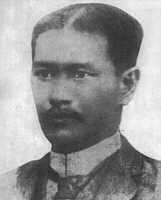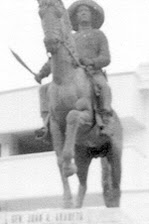The Forgotten Ilonggo Revolutionary Leader of 1898
(By DinggolAranetaDivinagracia - IlonggoNationMovement)
Hen. Roque Haplasca Lopez, “El Primer Presidente del Estado Federal de Bisayas”

Prologue: “While so many NHI historical markers and concrete monuments; more than life-size statues and bust; textbooks and magazines; main thoroughfares and remote places; and public plazas, schools and government buildings, etc. --were named to honor Don Eustaquio Hechanova Lopez first cousin, the Ilonggo National Hero named Graciano Lopez Jaena, none whatsoever in memory of the Don’s son Roque H. Lopez” --dinggol.d~~~
Brief Backgrounder:
At the turn of the 19th century, Maximo Lopez of Jaro, Iloilo City married Juana Hilaria. They had two sons; Fermin and Placido. Fermin married Fernanda Hechanova while Placido married Maria Jacobe Jaena, the parents of Graciano Lopez Jaena.
On the other hand, Maximo and Juana Hilaria-Lopez' eldest son Fermin who married Fernanda Hechanova were the parents of Eustaquio Hechanova Lopez who later acquired large tracts of land in Negros island and finally settled in Silay, Negros Occidental. The Barangay E. Lopez in Silay City used to be one of his Haciendas in Negros. Don Eustaquio financed his first cousin Graciano's trip to Spain in 1880 that would change the course of Philippine history.
Don Eustaquio Hechanova Lopez, first married Justina Haplasca with whom he had a son named Roque. When the Don became a widower, he remarried for the second and later for the third time in Negros.
Meanwhile, Roque H. Lopez who remained in Iloilo, would later join the "Comite de Conspiradores" of Parian (Molo) and expended his inheritance to finance the revolution of 1898 and to personally support families of the poor Ilonggo revolutionary forces, even to the extent of his bankruptcy.
The Comite de Conspiradores
The "Comite de Conspiradores" initiated by Don Francisco Felipe Villanueva and headed by Don Raymundo Angulo Melliza was formed in Parian, now Molo in Iloilo City on March 18, 1898. The initial members were "Parianons" that included; Pablo Araneta, Fernando Salas, Francisco Soriano, Jovito Yusay and from Jaro; Roque Haplasca Lopez and Don Simon Ledesma. This became the nucleus that started the highly disciplined and well organized, and the first-ever covert revolutionary movement in the Island of Panay.
Five months later, together with the revolutionary leaders outside the City led by Martin Teofilo Delgado y Bermejo of Sta. Barbara, they formed a revolutionary government and thus, the "Estado Federal de Bisayas" was conceived in the Town of Santa Barbara in Iloilo. Thereafter, Gen. Roque H. Lopez was elected President of the Assembly. . ."
Several Visayan Generals including Gen. Raymundo Melliza and Gen. Pablo Araneta chose Don Martin Teofilo Delgado as "General en Jefe de los Tropas del Ejercito Libertador de Visayas y Governador Politico-Militar” based in Sta. Barbara, Iloilo.

Thereafter, Gen. Roque H. Lopez, the elected President of the Assembly, and Gen. Pablo Soriano Araneta, as the chosen Panay Island Commanding General and Chief Expeditionary Forces for the Visayas; and other leaders of the Movement secretly maintained liaison with their relatives and friends in Negros and also nearby islands to start the armed uprising in their respective areas. More notably, the brothers Col. Emilio and Col. Eduardo Esteban as commissioned by the Chief of Staff, Gen. Pablo Araneta of the Expeditionary Forces for the Visayas.
Gen. Pantaleon “Leon Kilat” Villegas, of Bacong, in Negros Oriental --as directed by the Negros Island revolutionary leadership organized the Revolutionary forces in Cebu. He began the armed uprising against Spanish authorities in Carcar, Cebu together with Luis Flores, Florencio Gonzales, Candido Padilla, Andres Abellana, and others.
While Don Diego de la Viña, (a Spanish-Chinese mestizo from Manila married to a wealthy Ilongga) organized his rebel forces, mostly composed of his Hacienda Vallehermoso workers in the Town of Guihulngan, Negros Oriental.
Dr. Vicente Armada Locsin, of Janiuay, Iloilo acted as the Confidential Intelligence Emissary Officer of the Central Revolutionary Committee based in Molo, Iloilo City and coordinated with the Panay and Negros revolutionary councils. He later married Doña Trinidad Teves and settled permanently in Dumaguete City.
Fast forward:

On December 2, 1898, After a series of serious discussions and thorough legitimate deliberations on nation-building, it was decided to consolidate all of the cantonal governments in both Central and in Western Visayas into the Panay revolutionary government based in Iloilo; thus, the Estado Federal de Bisayas was established under President Roque H. Lopez with Vicente Franco as his Vice-President (from Dec. 2, 1898 to Jan. 7, 1899).
It is sad and regrettable, however, to note that there is no street named nor a historical marker installed to honor Gen. Roque H. Lopez, the Ilonggo patriot and first President of the "Estado Federal de Visayas" and many other Ilonggo leaders; Don Raymundo Melliza, Don Jovito Yusay, Don Fernando Salas, Gen. Angel Corteza, and others who fought hard and won the revolution against Spanish subjugation, thereby achieved the status as a truly independent and legitimate sovereign nation --before the "Faux pas" U.S. invasion in 1899 of the Visayan Federal Republic.
Epilogue: “Whereas, our main thoroughfares were named to immortalize the memories of our forebears’ adversaries and the revolutionary Losers in Luzon, such as; the Brgy. and street to honor Gen. Robert Hughes, Carpenters Bridge connecting Molo and Tabucan, Mandurriao; the Gen. Luna St. , Bonifacio Drive, M. H. del Pilar St., , J. M. Basa Street, etc., etc. --Likewise, to honor the memories of those former Ilonggo elitist leaders who readily collaborated with the early American invaders. . . Hamak mo ran Banwa!”--dinggolSDname~~~
Footnote:

It should be noted, that the National Historical Institute (NHI) marker commemorating Spain's formal surrender to the Negros Republic was only installed in the City of Bacolod, Negros Occidental --after 109 years on November 6, 2007.

Likewise, it was only in 2008 when the National Historical Institute (NHI) also erected a bust image and the historical marker to honor Don Diego de la Viña (The Liberator of Negros Oriental) at the City of Dumaguete Plaza in Negros Oriental. . . . . “Too late the Hero, sabi dah!” ~~~



















No comments:
Post a Comment